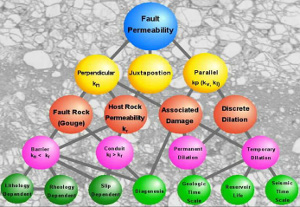| |||||||
|
|
|||||||
|
|
|||||||
| Porosity and Permeability of Faults | |||||||
|
Permeability of faults is expressed in two ways: (1) Juxtaposition of units due to slip and (2) fault zone permeability as shown in the diagram in Figure 1. The effect of juxtaposition is commonly accounted for the so-called Allan diagrams (Allan, 1989). Fault zone permeability may be broken down into two major components: fault perpendicular and fault parallel. The latter can be further classified as along strike and along dip.
For a full characterization of permeability of a fault zone, its components and architecture should be considered (Caine et al., 1996; Aydin, 2000; Bense et al., 2013). See the link for Components of Fault Zones below. Among the components, is fault rock also known as gouge, and includes damage zones, and discrete discontinuities such as slip surfaces and pull-aparts which are of prime importance for fluid flow and seismic behaviors of faults as discussed throughout this knowledgebase. All these aspects are dependent on the lithology of the faulted rock, its rheology during the faulting, slip and its temporal and spatial framework and diagenesis. Keep in mind that the impact of faults on fluid flow are graded with respect to the permeability of host rocks surrounding the faults. If, for example, the effective permeability of the fault zone is similar to that of the host rock, then, their effect on fluid flow may not be significant at all. | |||||||
| Types of Porosity and Permeability of Faults: | |||||||
| Porosity and Permeability of Sheared Joint-based Faults in SandstonePorosity and Permeability of Sheared Pressure Solution Seam-based Faults in CarbonatesPorosity and Permeability of Shear BandsPorosity and Permeability of Shale and Smeared Shale Porosity and Permeability affected by JuxtapositionUpscaled Fault Porosity and Permeability | |||||||
| Reference: |
|||||||
| Allan, U.S., 1989 Aydin, A., Myers, R., Younes, A.I., 1998 Aydin, A., 2000 Bense, V.F., Gleeson, T., Loveless, S.E., Bour, O., Sciebek, J., 2013 Caine, J. S., Evans, J.P., Forster, C.B., 1996 |
|||||||
|
Readme | About Us | Acknowledgement | How to Cite | Terms of Use | Ⓒ Rock Fracture Knowledgebase |
|||||||
